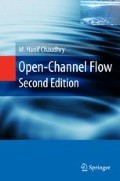In Section 12-3, we showed that the unsteady flow in open channels is described by a set of hyperbolic partial differential equations. These equations describe the conservation of mass and momentum in terms of the partial derivatives of dependent variables: flow velocity, V, and flow depth, y. However, for practical applications, we need to know the value of these variables instead of the values of their derivatives. Therefore, we integrate the governing equations. Because of the presence of nonlinear terms, a closed-form solution of these equations is not available, except for very simplified cases. Therefore, they are integrated numerically for which several numerical methods have been presented.
In this chapter, we introduce the method of characteristics and discuss necessary boundary and initial conditions for the numerical solution of governing equations. Various available numerical methods are presented and their advantages and disadvantages are briefly discussed.
Access this chapter
Tax calculation will be finalised at checkout
Purchases are for personal use only
Preview
Unable to display preview. Download preview PDF.
References
Abbott, M. B., 1966, An Introduction to the Method of Characteristics, Thames and Hudson, London, and American Elsevier, New York, NY.
Abbott, M. B., 1975, “Method of Characteristics,” Chapter 3 and ”Weak Solu-tion of the equations of Open Channel Flow,” Chapter 7 of Unsteady Open Channel Flow, (Mahmood, K., and Yevjevich, V. eds.), Water Resources Publications, Fort Collins, CO.
Abbott, M. B., 1979, Computational Hydraulics; Elements of the Theory of Free Surface Flows, Pitman Publishing Ltd., London.
Abbott, M. B., and Verwey, A., 1970, “Four-Point Method of Characteristics,” Jour. Hyd. Div., Amer. Soc. Civ. Engrs., vol 96, Dec., pp. 2549-2564.
Amein, M., and Fang, C. S., 1970, “Implicit Flood Routing in Natural Channels,” Jour. Hyd. Div., Amer. Soc. Civ. Engrs., vol. 96, Dec., pp. 2481-2500.
Anderson, D. A., Tannehill, J. C., and Pletcher, R. H., 1984, Computational Fluid Mechanics and Heat Transfer, McGraw Hill, New York, NY.
Baker, J. A., 1983, Finite-Element Computational Fluid Dynamics, McGraw-Hill, New York, NY.
Brebbia, C. A., and Dominguez, J., 1989, Boundary Elements, An Introductory Course, Computational Mechanics Publications, London.
Canuto, C., Hussaini, M. Y., Quarteroni, A., and Zang, T. A., 1988, Spectral Methods in Fluid Dynamics, Springer-Verlag, New York, NY.
Chaudhry, M. H., 1987, Applied Hydraulic Transients, 2nd ed., Van Nostrand Reinhold, New York, NY.
Craya, A., 1946, “Calcul graphique des regimes variables dans les canaux,” La Houille Blanche, no. 1, Nov. 1945-Jan 1946, pp. 79-138, and no. 2, Mar 1946, pp. 117-130.
Crossley, A. J., Wright, N. G., and Whitlow, C. D., 2003, “Local Time Stepping for Modeling Open Channel Flows,” Jour. Hyd. Engineering, Amer. Soc. Civ. Engrs., vol. 129, no. 6, pp.455-462.
Cunge, J., Holly, F. M., and Verwey, A., 1980, Practical Aspects of Computa-tional River Hydraulics, Pitman, London.
Dulhoste, J.F., Georges, D., and Besancon, G, 2004, “Nonlinear Control of Open-Channel Water Flow based on Collocation Control Model,” Jour. Hyd. Engineering, Amer. Soc. Civ. Engrs., vol. 130, no. 3, pp. 254-266.
Fread, D. L., and Harbaugh, T. E., 1973, “Transient Simulation of Breached Earth Dams,” Jour. Hyd. Div., Amer. Soc. Civil Engrs., Jan., pp. 139-154.
Katopodes, N., 1984, “A Dissipative Galerkin Scheme for Open-Channel Flow,” Jour. Hydraulic Engineering, Amer. Soc. Civ. Engrs., vol. 110, April, pp. 450-466.
Isaacson, E., Stoker, J. J., and Troesch, B. A., 1954, “Numerical Solution of Flood Prediction and River Regulation Problems (Ohio-Mississippi Floods),” Report II, Inst. Math. Sci. Rept. IMM-NYU-205, New York University.
Lai, C., 1986, “Numerical Modeling of Unsteady Open-Channel Flow,” in Ad-vances in Hydroscience, vol. 14, Academic Press, New York., pp. 161-333.
Lai, C., 1988, “Comprehensive Method of Characteristics Models for Flow Sim-ulation,” Jour. Hydraulic Engineering, Amer. Soc. Civil Engrs., vol. 114, no. 9, pp. 1074-1097.
Lax, P. D., 1954, “Weak Solutions of Nonlinear Hyperbolic Partial Differential Equations and Their Numerical Computation,” Communications on Pure and Applied Mathematics,” vol. 7, pp. 159-163.
Leendertse, J. J., 1967, “Aspects of a Computational Model for Long Period Water-Wave Propagation,”Memo RM-5294-PR, Rand Corporation, May.
Liggett, J. A., 1984, “The Boundary Element Method - Some Fluid Applications,” in Multi-Dimensional Fluid Transients, (Chaudhry, M. H., and Martin, C. S. eds.), Amer. Soc. Mech. Engrs., Dec., New York, NY, pp. 1-8.
Litrico, X., and Fromion V., 2004, “Frequency Modeling of Open-Channel Flow,” Jour. Hyd. Engineering, Amer. Soc. Civ. Engrs., vol. 130, no. 8, pp. 806-815.
Massau, J., 1889, “L’integration graphique and Appendice au memoire sur l’integration graphique,” Assoc. des Ingenieurs sortis des Ecoles Speciales de Gand, Belgium, Annales, vol. 12, pp. 185-444.
Price, R. K., 1974, “Comparison of Four Numerical Flood Routing Methods,” Jour. Hyd. Div., Amer. Soc. Civ. Engrs., vol. 100, July, pp. 879-899.
Richtmyer, R. D., and Morton, K. W., 1967, Difference Methods for Initial Value Problems, 2nd. ed., Interscience, New York, NY.
Stoker, J. J., 1957, Water Waves, Interscience, New York, NY.
Strelkoff, T., 1970, “Numerical Solution of St. Venant Equations,” Jour. Hyd. Div., Amer. Soc. Civ. Engrs., vol. 96, January, pp. 223-252.
Terzidis, G., and Strelkoff, T., 1970, “Computation of Open Channel Surges and Shocks,” Jour. Hyd. Div., Amer. Soc. Civ. Engrs., vol. 96, Dec., pp. 2581-2610.
Ying, X., Khan, A. A., and Wang, S. S. Y., 2004, “Upwind Conservative Scheme for the Saint Venant Equations,” Jour. Hyd. Engineering, Amer. Soc. Civ. Engrs., vol. 130, no. 10, pp. 977-987.
Rights and permissions
Copyright information
© 2008 Springer Science+Business Media, LLC
About this chapter
Cite this chapter
(2008). Numerical Methods. In: Open-Channel Flow. Springer, Boston, MA. https://doi.org/10.1007/978-0-387-68648-6_13
Download citation
DOI: https://doi.org/10.1007/978-0-387-68648-6_13
Publisher Name: Springer, Boston, MA
Print ISBN: 978-0-387-30174-7
Online ISBN: 978-0-387-68648-6
eBook Packages: EngineeringEngineering (R0)

